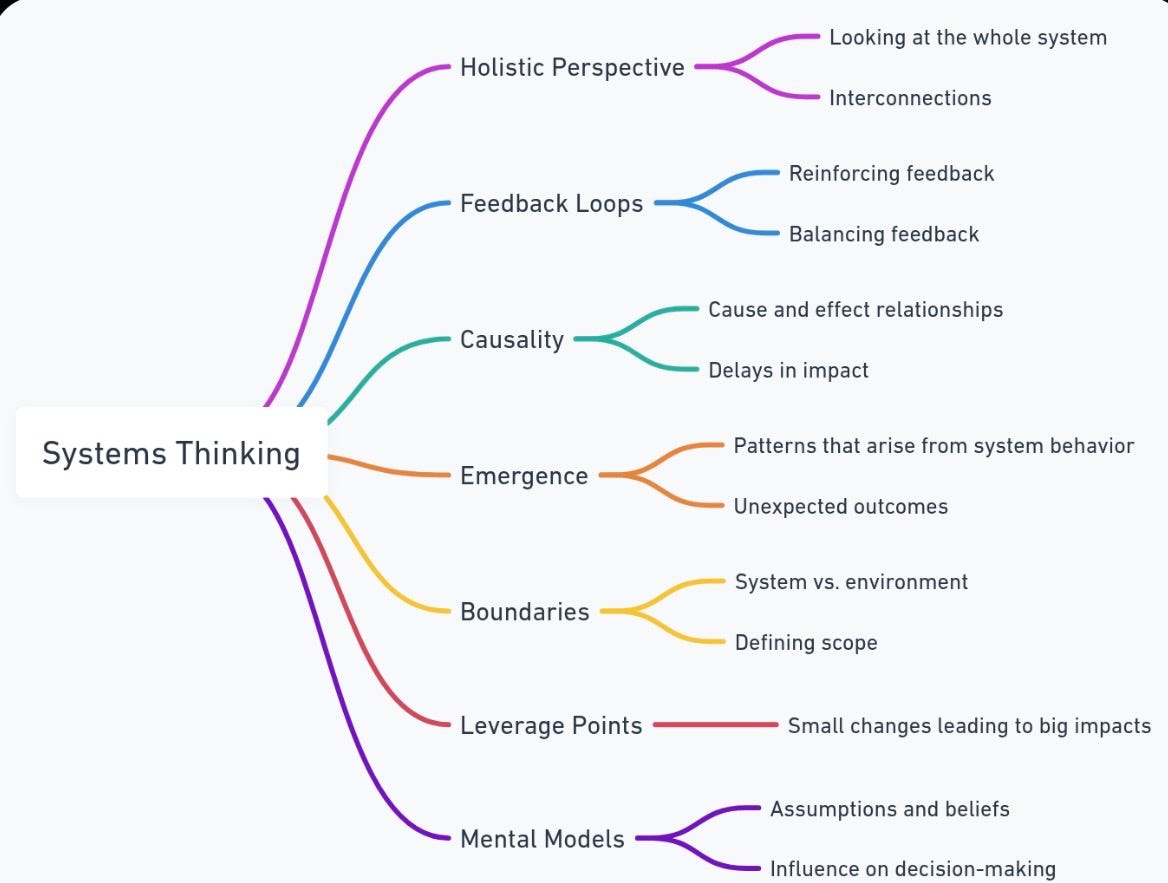Most of us were raised to think in straight lines: “If I do X, I’ll get Y.”
But life — and business — rarely work that way. Instead, everything is connected. Every choice has ripple effects. Every “quick fix” hides longer-term consequences.
That’s where systems thinking comes in. It’s a way of seeing how all the moving parts of your business, content, and even mindset work together. And if you’re building a one-person creator business (with a little help from IMMachines GPTs), it’s a superpower.
Let’s break it down in plain English, using the seven principles from the graphic above. ( I came across this graphic on Substack and wanted to understand more deeply the meaning of it!)
1. Holistic Perspective – See the Forest and the Trees
Instead of looking at one task in isolation (“I just need more leads”), systems thinking asks: how does this fit into the bigger picture?
-
Leads connect to your content system.
-
Content connects to your offer system.
-
Offers connect to your audience’s trust system.
When you zoom out, you stop chasing random tactics. You see the interconnections and can design smoother flows.
👉 Try this with IMMachines: Navigator GPT — it shows you how each of your business parts connects to the right tool or system.
2. Feedback Loops – Business is a Conversation
In systems, feedback comes in two flavours:
-
Reinforcing feedback: Momentum builds on itself. Example: more valuable content → more shares → more subscribers → more motivation to create.
-
Balancing feedback: Something pushes back to keep things in check. Example: more leads → more customer service requests → your time gets stretched.
Ignoring feedback loops leads to burnout. Designing with them in mind helps you grow sustainably.
👉 Use Daily Micro-Content Machine GPT to set up reinforcing loops with bite-sized content that drives consistent growth without overwhelming you.
3. Causality – It’s Not Instant
We love instant results, but systems often have delayed impacts. If you plant seeds today (like posting daily for 90 days), the harvest doesn’t show up tomorrow.
The danger? Many solopreneurs quit before the system “pays out.” (I hear this time and again from entrepreneurs and it teaches us that we must keep going forward in order to gain traction.)
👉 From Chaos to Clarity GPT can help you prioritize actions with delayed returns, so you don’t abandon what’s working too soon.
4. Emergence – Expect Surprises
Systems often create unexpected patterns. You may design your newsletter to drive course sales, but it ends up building a thriving coaching community.
The point? Don’t try to control every detail. Instead, watch for surprising patterns and lean into them.
👉 Our Offer Optimiser GPT helps you pivot unexpected outcomes into polished offers.
5. Boundaries – Define Your Sandbox
Every system has boundaries. If you try to solve everything for everyone, you burn out. The art is defining your scope: “Who am I serving? Where does my responsibility end?”
👉 Thought-Leader Engine GPT helps clarify your positioning and boundaries so you can lead with authority without spreading yourself too thin.
6. Leverage Points – Tiny Tweaks, Big Payoffs
This is the gold mine. In systems, small shifts can create huge results.
-
One irresistible headline can double conversions.
-
One automation can free 5 hours a week.
-
One viral hook can add 10,000 followers.
👉 That’s why tools like Prompt Builder Pro GPT and Sales Angle Generator GPT exist — they give you leverage points to unlock disproportionate results.
7. Mental Models – The Invisible System
Finally, the biggest system of all is the one inside your head. Your assumptions and beliefs shape how you act. If you believe “selling is sleazy,” no funnel in the world will save you.
👉 Use Sales Angle Generator GPT to reframe your beliefs around offers and discover authentic ways to sell that align with your values.
Wrapping It All Up
Systems thinking is about zooming out, noticing patterns, and adjusting with awareness. For solopreneurs and creators, it means:
-
Stop chasing hacks.
-
Start building processes that reinforce themselves.
-
Look for leverage points.
-
Update your mental models when they hold you back.
The truth is, your business is a system — and so is your mindset. Once you see that, you can work with the system instead of against it.
And that’s exactly why we built the IMMachines GPT suite: so you’re not patching holes randomly, but designing a whole system that works together to make you unstoppable.
✨ Next Step for Readers:
Ask yourself: Where in my business am I only seeing the tree, but not the forest? That’s your cue to start applying systems thinking today.






